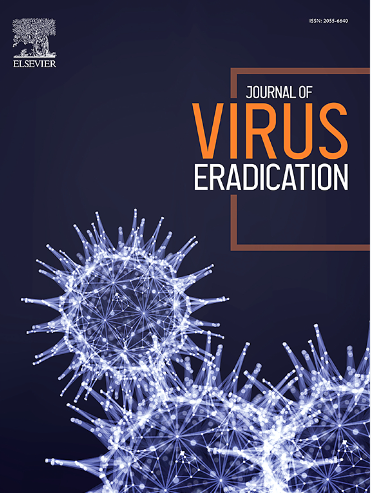停止含替诺福韦抗逆转录病毒治疗的HIV-HBV合并感染患者的病毒学和血清学结果:一项前瞻性队列研究的结果
IF 2
4区 医学
Q2 IMMUNOLOGY
引用次数: 0
摘要
背景和目的鉴于抗逆转录病毒治疗(ART)的进展,一些艾滋病毒感染者转向不含替诺福韦的抗逆转录病毒治疗;对艾滋病毒-乙型肝炎病毒(HBV)感染者的影响尚不清楚。我们在未服用含替诺福韦抗逆转录病毒药物的HIV-HBV合并感染患者中观察了与hbv相关的结果。方法:我们对来自法国HIV-HBV队列研究的参与者进行了三个治疗组的分析:(1)连续替诺福韦;(2)停用替诺福韦;(3)从未开始使用替诺福韦。我们在随访期间检查了病毒学和临床特征。当受试者停用替诺福韦时,我们分别使用单变量logistic回归和广义估计方程评估了HBV DNA和丙氨酸转氨酶(ALT)的决定因素2000iu /mL和正常上限的2倍。结果在192名参与者中,在14.5年的中位随访期间(IQR = 10.5-14.8), 161人(83.9%)持续使用替诺福韦,22人(11.5%)停止使用替诺福韦,9人(4.7%)从未使用过替诺福韦。未检测到HBV DNA的患者访诊中位数比例在连续用药组为96.0% (IQR = 75.0-100),在停用替诺福韦组(同时停用替诺福韦)为100% (IQR = 84.0-100),在未开始使用替诺福韦组为100% (IQR = 95.2-100)。停用替诺福韦时HBV DNA的决定因素为:HIV RNA检测(p = 0.041)、CD4+ t细胞计数降低(p = 0.027)、HBeAg血清学阳性(p = 0.004)和D型肝炎血清学阳性(p = 0.001)。ALT升高与丙肝抗体血清学阳性相关(p = 0.012)。结论:这一概念验证性研究表明,选定的HIV-HBV合并感染患者在停用替诺福韦后可能不会失去对HBV的病毒学控制。停用替诺福韦时HBV病毒学活性可能与未控制的HIV感染和HBeAg阳性血清学更密切相关。本文章由计算机程序翻译,如有差异,请以英文原文为准。
Virological and serological outcomes in people with HIV-HBV coinfection who had discontinued tenofovir-containing antiretroviral therapy: Results from a prospective cohort study
Background and Aims
Given advances in antiretroviral therapy (ART), some people with HIV are transitioned to non-tenofovir-containing ART; the implications for people with HIV-hepatitis B virus (HBV) are unknown. We characterized HBV-related outcomes in people with HIV-HBV coinfection while not taking tenofovir-containing ART.
Methods
We analyzed participants from the French HIV-HBV Cohort Study in three treatment groups: (1) continuous tenofovir; (2) discontinued tenofovir; (3) never initiated tenofovir. We examined virological and clinical characteristics during follow-up. We assessed determinants of HBV DNA >2000 IU/mL and alanine aminotransferase (ALT) >2x upper limit of normal separately while participants were off tenofovir using univariable logistic regression with generalized estimating equations.
Results
Among 192 participants, 161 (83.9 %) were on continuous tenofovir, 22 (11.5 %) discontinued tenofovir, and 9 (4.7 %) never initiated tenofovir during a median follow-up of 14.5 years (IQR = 10.5–14.8). The median proportion of within-participant visits with undetectable HBV DNA was 96.0 % (IQR = 75.0–100) in the continuous group, 100 % (IQR = 84.0–100) in the discontinued tenofovir group (while off tenofovir), and 100 % (IQR = 95.2–100) in the never initiated tenofovir group. Determinants of HBV DNA >2000 IU/mL while people were off tenofovir were detectable HIV RNA (p = 0.041), lower CD4+ T-cell count (p = 0.027), HBeAg positive serology (p = 0.004) and positive hepatitis D serology (p = 0.001). ALT elevation was associated with positive hepatitis C antibody serology (p = 0.012).
Conclusions
This proof-of-concept study shows that selected people with HIV-HBV coinfection may not lose virologic control of HBV when off tenofovir. HBV virologic activity while off tenofovir may be more closely associated with uncontrolled HIV infection and positive HBeAg serology.
求助全文
通过发布文献求助,成功后即可免费获取论文全文。
去求助
来源期刊

Journal of Virus Eradication
Medicine-Public Health, Environmental and Occupational Health
CiteScore
6.10
自引率
1.80%
发文量
28
审稿时长
39 weeks
期刊介绍:
The Journal of Virus Eradication aims to provide a specialist, open-access forum to publish work in the rapidly developing field of virus eradication. The Journal covers all human viruses, in the context of new therapeutic strategies, as well as societal eradication of viral infections with preventive interventions.
The Journal is aimed at the international community involved in the prevention and management of viral infections. It provides an academic forum for the publication of original research into viral reservoirs, viral persistence and virus eradication and ultimately development of cures.
The Journal not only publishes original research, but provides an opportunity for opinions, reviews, case studies and comments on the published literature. It focusses on evidence-based medicine as the major thrust in the successful management of viral infections.The Journal encompasses virological, immunological, epidemiological, modelling, pharmacological, pre-clinical and in vitro, as well as clinical, data including but not limited to drugs, immunotherapy and gene therapy. It is an important source of information on the development of vaccine programs and preventative measures aimed at virus eradication.
 求助内容:
求助内容: 应助结果提醒方式:
应助结果提醒方式:


